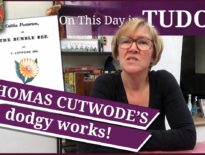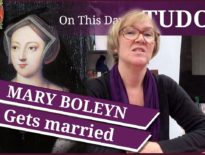On this day in Tudor history, 5th February 1549, in the reign of King Edward VI, fifteen-year-old Elizabeth, the future Queen Elizabeth I, was summoned to appear before Sir Robert Tyrwhitt, who was keeping her under house arrest at Hatfield while the Crown investigated Thomas Seymour.
Edward VI's privy council were investigating whether Elizabeth was secretly plotting to marry Thomas Seymour, Edward VI's uncle, helped by her servants, Katherine Ashley and Thomas Parry.
Parry and Ashley had made confessions, but what had they said? And what would happen to them all?
Find out in today's talk.
You can read the confessions of Thomas Parry, Katherine Ashley and Elizabeth at https://archive.org/details/bub_gb_YitDAAAAcAAJ/page/n109/mode/2up p. 95 to 103.
Book recommendation: The Temptation of Elizabeth Tudor by Elizabeth Norton.
Also on this day in Tudor history, 5th February 1537, in the reign of King Henry VIII, diplomat Sir Henry Brooke was born. Find out all about him in last year’s video:
Also on this day in history:
- 1556 – Treaty of Vaucelles between Philip II of Spain and Henry II of France. By the terms of this treaty, Henry II had to relinquish Franche-Comté to Philip, but the treaty was quickly broken.
- 1557 – Death of Sir William Portman, Judge and Lord Chief Justice of England and Wales from 1555. He was buried at St Dunstan-in-the-West, Fleet Street, London.
- 1576 – Henry of Navarre, the future Henry IV of France, abjured Catholicism at Tours, rejoining the Protestant forces, following his escape from Paris on 3rd February.
- 1605 – Death of Sir Edward Stafford, son of Sir William Stafford (Mary Boleyn's second husband) and his second wife Dorothy Stafford. Edward was an MP and diplomat, and there is controversy over his "spying" activities during the Armada and exactly how much information he passed to Mendoza. He was buried in St Margaret's, Westminster.
Transcript:
On this day in Tudor history, 5th February 1549, in the reign of King Edward VI, fifteen-year-old Elizabeth, the future Queen Elizabeth I, was summoned to appear before Sir Robert Tyrwhitt. Tyrwhitt and his wife were keeping Elizabeth under house arrest at Hatfield while investigations were underway concerning whether Elizabeth was involved with her governess Katherine Ashley and her cofferer Thomas Parry, in a plot with Thomas Seymour. Thomas Seymour had been arrested and he would be charged with 33 counts of treason, including planning to marry Elizabeth without the consent of the king and royal council.
The previous day, 4th February 1549, Tyrwhitt had sent Ashley and Parry’s confessions to the princess, along with a letter from Edward Seymour, Duke of Somerset and Lord Protector, and now he wanted Elizabeth’s thoughts on what her staff had said.
Katherine Ashley and Thomas Parry had been arrested on 21st January 1549 and taken to the Tower of London, and the following day, Tyrwhitt had been sent to Hatfield by Somerset to investigate Elizabeth’s part in the plot. Elizabeth would not implicate herself in any plot, but Thomas Parry confessed to meetings with Thomas Seymour, mention of a potential marriage between him and Elizabeth, and talking to Elizabeth of Seymour’s offer of marriage. He also dropped Ashley in it, writing of how she had told him about Catherine Parr’s jealousy over the closeness of Elizabeth and Seymour while Elizabeth was in her household, and how Catherine had found them in each other’s arms. When Ashley was brought face to face with Parry and saw that he had confessed and was sticking to it, she was appalled and called him “false wretch”, but she then went on to make her confession, recounting the stories of Seymour’s inappropriate behaviour at Chelsea, Hanworth and Seymour Place, his morning visits to Elizabeth’s chamber while she was in bed and not dressed, and him slashing the princess’s gown to pieces.
On this day in 1549, Tyrwhitt reported back to Somerset that Elizabeth was “much abashed and half breathless” when she read Katherine Ashley’s words. Elizabeth must have been shocked when she read the words of her faithful servants, and she must have been terror-stricken too, wondering what would happen to them all. Fortunately for Elizabeth, and unfortunately for Tyrwhitt and the Privy Council, Ashley and Parry’s confessions did not provide evidence that Elizabeth and Seymour had plotted to marry and take the throne, just that there had been some inappropriate behaviour in 1548. As historian J L McIntosh notes, Elizabeth’s servants “steadfastly depicted their mistress as always refusing to contribute to any talk of marriage with Seymour”, and in her own confession, written on 7th February, Elizabeth did not implicate herself, only accepting what Parry and Ashley had stated. She stated that Ashley had told her that Seymour had wanted to marry Elizabeth before he’d married Catherine Parr, and that following Catherine’s death he had plans to woo Elizabeth, but Elizabeth stated that “though he himself would peradventure have me, yet I think the council will not consent to it”, showing that she would never do anything without consulting the king and his council. Nothing that Parry, Ashley or Elizabeth herself confessed to could be taken as treason. As Tyrwhitt told Somerset, “they all sing the same song”, and although Seymour was executed on 20th March 1549, Elizabeth was safe, as were her servants, who were eventually released and reinstated to her household.
When Elizabeth became queen, she appointed Parry as her Comptroller of the Household, and Ashley became her chief gentlewoman of the privy chamber. They served Elizabeth loyally for the rest of their lives.
Book recommendation: The Temptation of Elizabeth Tudor by Elizabeth Norton.



That was a very interesting book! Michelle t
This is were we have to be cautious when accusations arise that Tom Seymour groomed or tried to abuse Princess Elizabeth in her stepmother’s home. This evidence was given under duress and may not even be true.
It is another matter that he wanted to marry Elizabeth at some point
because he was overly ambitious and Elizabeth herself admitted she received his respectful offer but would not consider it without the permission of the Council. She wasn’t daft, her fortune and inheritance depended on her not doing so and I doubt she considered it anyway.
Katherine Parr was very disappointed and grieved to see Elizabeth and her husband kissing and hugging as she was heavily pregnant and had taken Elizabeth under her wing. She wisely sent Elizabeth away, for her own protection. Tom Seymour was a bit of a rogue and a hero. He was quite handsome and debonair. Elizabeth probably did have a crush on him, but he was the grown-up here and took advantage of a young woman. I say young woman based on the standard of the day, at fifteen she was hardly that. He was a much older man, at least twice her age or more and he was married. Even a kiss was very inappropriate.